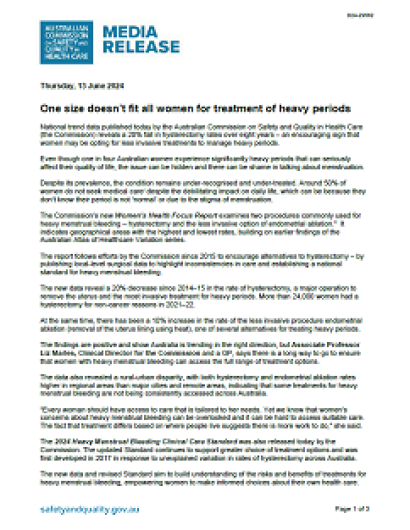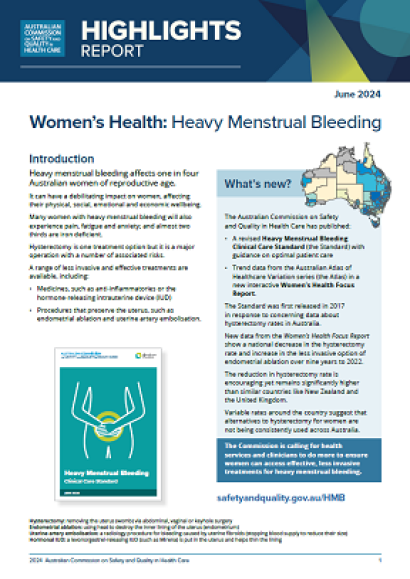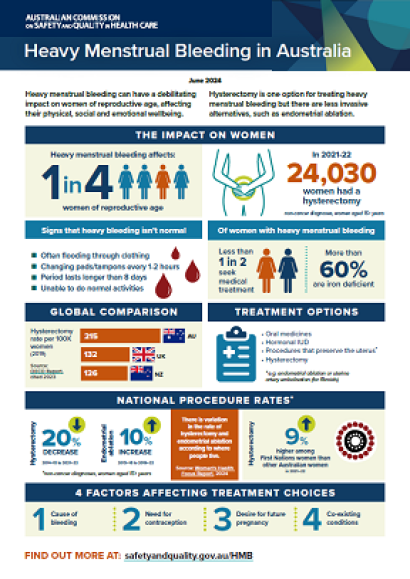National trend data published today by the Australian Commission on Safety and Quality in Health Care (the Commission) reveals a 20% fall in hysterectomy rates over eight years – an encouraging sign that women may be opting for less invasive treatments to manage heavy periods.
Even though one in four Australian women experience significantly heavy periods that can seriously affect their quality of life, the issue can be hidden and there can be shame in talking about menstruation.
Despite its prevalence, the condition remains under-recognised and under-treated. Around 50% of women do not seek medical care[i] despite the debilitating impact on daily life, which can be because they don’t know their period is not ‘normal’ or due to the stigma of menstruation.
The Commission’s new Women’s Health Focus Report examines two procedures commonly used for heavy menstrual bleeding – hysterectomy and the less invasive option of endometrial ablation.[ii] It indicates geographical areas with the highest and lowest rates, building on earlier findings of the Australian Atlas of Healthcare Variation series.
The report follows efforts by the Commission since 2015 to encourage alternatives to hysterectomy – by publishing local-level surgical data to highlight inconsistencies in care and establishing a national standard for heavy menstrual bleeding.
The new data reveal a 20% decrease since 2014–15 in the rate of hysterectomy, a major operation to remove the uterus and the most invasive treatment for heavy periods. More than 24,000 women had a hysterectomy for non-cancer reasons in 2021–22.
At the same time, there has been a 10% increase in the rate of the less invasive procedure endometrial ablation (removal of the uterus lining using heat), one of several alternatives for treating heavy periods.
The findings are positive and show Australia is trending in the right direction, but Associate Professor Liz Marles, Clinical Director for the Commission and a GP, says there is a long way to go to ensure that women with heavy menstrual bleeding can access the full range of treatment options.
The data also revealed a rural-urban disparity, with both hysterectomy and endometrial ablation rates higher in regional areas than major cities and remote areas, indicating that some treatments for heavy menstrual bleeding are not being consistently accessed across Australia.
“Every woman should have access to care that is tailored to her needs. Yet we know that women’s concerns about heavy menstrual bleeding can be overlooked and it can be hard to access suitable care. The fact that treatment differs based on where people live suggests there is more work to do,” she said.
The 2024 Heavy Menstrual Bleeding Clinical Care Standard was also released today by the Commission. The updated Standard continues to support greater choice of treatment options and was first developed in 2017 in response to unexplained variation in rates of hysterectomy across Australia.
The new data and revised Standard aim to build understanding of the risks and benefits of treatments for heavy menstrual bleeding, empowering women to make informed choices about their own health care.
“Heavy periods are a hidden problem that a lot of women live with,” said A/Professor Marles. It can be a sensitive topic that some women do not feel comfortable raising with their doctor. The Commission’s work advocates on behalf of these women, many of whom have had their life substantially affected.”
She also said it was concerning that Australia’s rate of hysterectomy remains significantly higher than comparable OECD countries like New Zealand and the United Kingdom,[iii] suggesting women who seek help may have a more invasive procedure than is necessary.
A/Professor Marles said the Commission was seeking three important outcomes. “Firstly, we want women to know they don’t have to put up with symptoms, to feel comfortable talking about their periods and to be aware that there are a range of treatments, which don’t necessarily involve a major operation.
“Let’s also upskill the healthcare workforce so women are offered the full suite of treatment options, and practitioners can deliver minimally invasive treatments if appropriate, such as the hormonal IUD.
“Finally, health practitioners need to ask women about their menstrual health and tailor care to individual needs, so they receive the most suitable treatment, which differs for each woman,” she said.
Higher hysterectomy rates among First Nations women emphasised the need for culturally appropriate care, added A/Professor Marles, with the new Standard offering guidance to help improve equity.
“While some women may choose hysterectomy, we want to avoid them going straight to the most invasive procedure, without being offered less invasive and effective alternatives and information on the risks and benefits. Hysterectomy cannot be reversed and has increased risk of complications,” she said.
The right treatment can be life-changing
Professor Kirsten Black, a gynaecologist with the University of Sydney and a member of expert advisory groups for the Standard and the Women’s Health Focus Report, said the impact of heavy menstrual bleeding on a woman’s health and quality of life remains under-recognised.
“It has been great that we have seen a shift towards less invasive gynaecology procedures since the first Heavy Menstrual Bleeding Clinical Care Standard was introduced in 2017,” she said.
“We know that many women with heavy menstrual bleeding can be successfully managed by their GP or other primary care practitioner using medical treatments like the hormonal IUD.”
Professor Black said it was important to do a proper initial assessment to identify whether there is a specific cause that may need to be addressed and to check for iron deficiency[iv] and anaemia.
“Healthcare providers need to understand their patient’s menstrual history and whether the bleeding prevents them from going about daily activities and interacting socially. Some women feel they can’t leave the house when they've got their period because of fear of excessive bleeding,” she explained.
“For women with heavy menstrual bleeding, finding the right treatment has potential to be life-changing.”
Quotes attributable to Assistant Minister for Health and Aged Care, Ged Kearney MP:
“Women’s health has for too long been overlooked, ignored and dismissed.
“Heavy periods can seriously impact a woman’s quality of life. I know, I have had very personal experience of this, along with one in four women.
“As a former nurse, I implore all women who are concerned to talk to a trusted healthcare provider about menstrual bleeding. You don’t need to suffer in silence, there are many options to get help.”
More information: safetyandquality.gov.au/HMB



